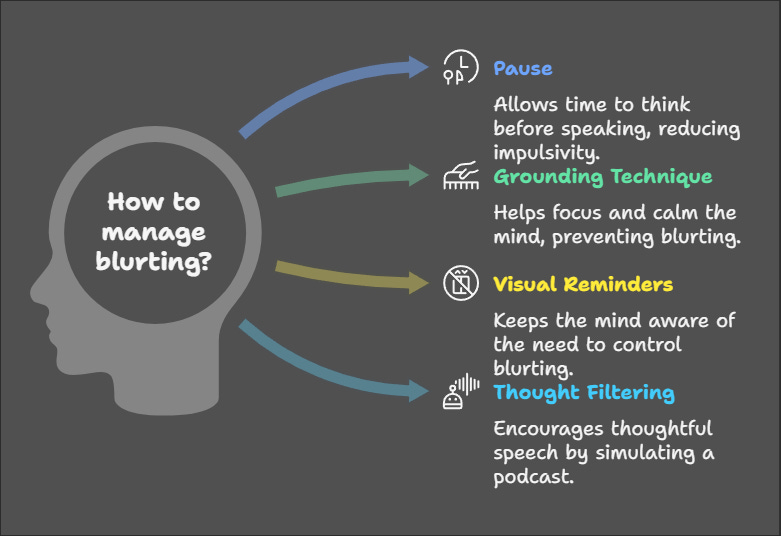🗣️ADHD Blurting: Why It Happens and How to Control It 🚫💬
Unlock better communication and build stronger relationships by mastering the art of thought-before-speech. 🌟💡
🔥 That Awkward Moment…
You’re in a meeting, and before your brain can hit the brakes, the words spill out:
❌ "That’s a terrible idea."
Silence. The room stiffens. Your boss glares. You scramble to explain, but it’s too late.
Or maybe you’re chatting with a friend, and you accidentally blurt out a deep secret they trusted you with. Their eyes widen. You see the hurt on their face.
👉 Why did I just say that?!
If this sounds familiar, you’re not alone. Blurting—saying things without thinking—is a classic ADHD trait. It can strain relationships, create misunderstandings, and make you feel like your mouth has a mind of its own. But why does this happen? And more importantly, how can you stop?
Let’s dive in! 🚀
🧠 What Is Blurting?
Blurting is the impulsive act of speaking without filtering thoughts, often interrupting, oversharing, or saying inappropriate things.
It’s common in ADHD due to differences in impulse control, working memory, and emotional regulation.
⚡ When Does It Strike?
🔴 Excitement: You can’t hold back an idea.
😰 Anxiety: You feel the need to fill silences.
🤯 Overwhelm: Your emotions override logic.
🗣️ Fast Conversations: You fear losing your turn.
🧐 Why Does This Happen? (The ADHD Brain at Work)
Blurting isn’t just a “bad habit”—it’s brain wiring. ADHD affects the prefrontal cortex, the part of the brain responsible for impulse control and decision-making.
🔬 Scientific Backing:
📉 Lower dopamine levels: ADHD is associated with lower levels of dopamine, a neurotransmitter that helps regulate impulses and motivation. This leads to difficulty inhibiting automatic responses, such as blurting out thoughts (Barkley, 2018).
🧠 Weaker working memory: Working memory helps us hold information temporarily, which allows us to think before we act. ADHD often involves impairments in working memory, meaning we can struggle to hold back words long enough to process them (Alderson et al., 2013).
⚡ Emotional impulsivity: Research shows that ADHD is linked to emotional dysregulation, meaning feelings like excitement, anxiety, or frustration can hijack decision-making, leading to impulsive blurting (Sonuga-Barke et al., 2010).
💡 Translation? Your brain moves faster than your filter, making it hard to pause before speaking. You may speak impulsively without having the cognitive tools to stop yourself in time.
✅ 5 ADHD-Proof Strategies to Stop Blurting
1️⃣ The 3-Second Rule ⏳
Before speaking, silently count “1…2…3” in your head. This tiny pause helps your brain catch up and decide if the thought should be spoken or kept inside.
2️⃣ The Finger Tap Method 👆
When an impulse hits, tap your thumb against each fingertip. This small movement grounds your brain and gives you an extra second to think before speaking.
3️⃣ The Post-It Reminder 📌
Write down: “Pause. Think. Speak.” on a sticky note where you can see it—on your desk, laptop, or phone. A visual cue reminds you to slow down.
4️⃣ The "Internal Podcast" Trick 🎙️
Imagine you're on a live podcast, and everything you say will be broadcasted. Would you still say it? If not, edit your response before speaking.
5️⃣ The Rewind & Repair Approach 🔄
Blurting happens. When it does, own it and correct it:
✅ “Oops, that came out wrong. What I meant was…”
✅ “I spoke too fast—let me rephrase.”
People appreciate honesty more than awkward silence.
🎭 Real-Life Example: From Blurting Disaster to Blurt Control
🔥 Before:
Jake, a software developer, constantly interrupted meetings with impulsive comments. His coworkers grew frustrated, and his boss even told him to "hold his thoughts" until the end of discussions.
🚀 After Applying Strategies:
✔️ Used the 3-second rule to pause before speaking.
✔️ Kept a sticky note on his desk as a reminder.
✔️ Practiced the "Internal Podcast" trick to filter his words.
Now? Fewer interruptions, better relationships, and no more cringe moments.
🎯 Action Plan: Fix Blurting in 3 Steps
✅ Step 1: Understand Your Triggers
Are you blurting when anxious? Excited? In social settings?
Identify when it happens most and stay mindful.
✅ Step 2: Use the 5 Strategies Daily
⏳ Pause for 3 seconds before speaking.
👆 Tap your fingers to ground impulses.
📌 Keep a sticky note as a visual reminder.
🎙️ Think: “Would I say this on a live podcast?”
🔄 Own mistakes & rephrase when needed.
✅ Step 3: Track Progress & Celebrate Wins
Each time you catch yourself before blurting, celebrate it.
Small wins rewire your brain for better impulse control.
🔥 Quick Recap: The 5 Blurting Fixes
💡 Pause before speaking (3-second rule).
🖐️ Use a grounding technique (finger tap).
📌 Keep visual reminders (sticky note).
🎙️ Filter thoughts with the “live podcast” trick.
🔄 Own mistakes & rephrase when needed.
🚀 Final Thought: Your Words, Your Control.
Blurting doesn’t define you. With practice, you’ll go from impulsive speaker to thoughtful communicator—without losing your personality.
🎯 Try one of these strategies today.
💬Then tell me—which one worked best for you? 👇
📢 Share this with someone who needs it!
You got this! 💡
Rgds
Lud




Dude! I just subscribed and this is way better than I expected! At first glance, it looks very thorough, very rigorous, well-researched/documented, and has a thoughtful, well-crafted ontological design for ADHDers.
Right now I have to go back to ADHD Entrepreneurs, but you are now a high priority in my Substack.